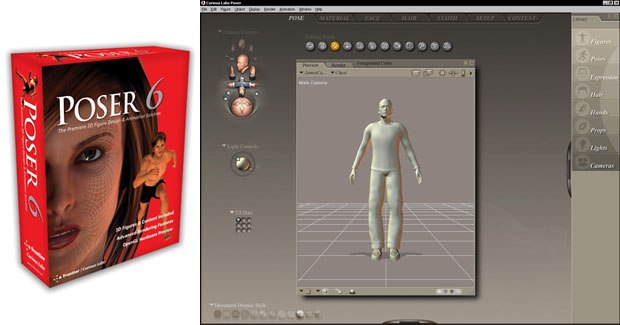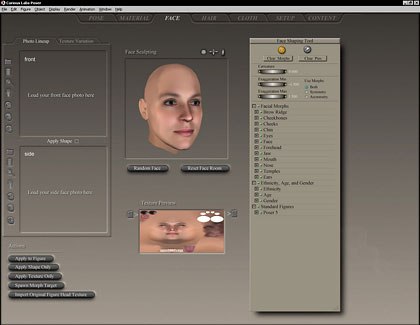Janet Hetherington checks in with independent animators across Canada to find out whats hot and whats not on the Canadian animation scene.

The corporate entity may have changed, but Poser 6 is still a unique piece of software known for its ease of use and high quality output. All screen captures by Fred Galpern.
Curious Labs released Poser 6 this past March. If you happen to read about a company called e frontier America Inc. claiming to be the Poser developer, please, dont be confused. Its simply a corporate name change to allow the American branch to coordinate more closely with their Japanese parent company, e frontier. For Poser 6, they will transition the company name, presumably until its users become accustomed to the new e frontier title. Corporate confusion aside, Poser 6 is still a unique piece of software. The 3D figure software has long been known amongst hobbyists and professionals alike for its ease of use and high quality output. In addition to human figures, users can pose, texture, light, animate and render four-legged animals or even create their own unique creatures. For this review, I will focus exclusively on the Windows 2000/XP version. Mac users need not fret; there is also a Mac OS X version available.

Two new human figures, James and Jessi, are highlighted in version 6.
There are many new features in this upgrade from version 5, which was released back in the summer of 2003. There are two new human figures highlighted in this release, James and Jessi. One male and the other female, can you guess which is which? Poser includes a genitalia toggle for the shy or younger users. Serious artists will most likely switch it on and forget about it, but e frontier is wise to include the option. There are many other figures that ship with the software, including other humans, various animals, cartoon figures, robots and a sampling of premium content offered by third party vendors. Also included is a large library of poses, hairdos and clothing for the figures. OpenGL hardware acceleration, cartoon render effects and improved Flash export are some of the other additions in version 6.
3D professionals will be hard pressed to find another piece of software to compare Poser to, mostly due to its distinctive user interface. The UI takes some getting used to but given an hour or so pros should feel quite comfortable. Beginners on the other hand might need to read the documentation. If youre jumping from a 2D app, such as Photoshop or Illustrator, put your learning hat on and read, especially the introductory section that explains 3D workspaces. This section is well written, easy to follow and will provide information that will be useful when you move to one of the more advanced 3D packages someday. Working in 3D space isnt always easy to pick up but Poser is a great way to get started, again mostly because of its simple yet effective UI.
The UI takes some getting used to, but is simple and effective.
The interface is broken up into tabs, buttons, click and use tools and one 3D window. This window is scalable for users wishing to customize their experience. The top left of the screen is reserved for camera controls. With these excellent icons users can rotate, pan, zoom and generally adjust the camera as well as most high-end 3D apps. Sure, the interface is friendlier in appearance when compared to 3ds Max or Maya, but it works well and thats what counts. Just to the right of the camera controls are seven tabs that allow users to enter what the developers have dubbed rooms. This term is again a compromise aimed at the hobbyists or beginners. These rooms are really just rearranged UI setups focused on particular tasks. Users may choose from pose, material, face, hair, cloth, setup and content. The face room is a good example of the power of these custom UI setups. Gone are the camera controls and instead users see a clear display of the currently selected figures head along with a separate window displaying the texture currently applied to that figure. There are controls for each part of the head, which allow the user to customize the face endlessly. These controls are fairly well implemented but could be improved. One disturbing thing about these controls is that they are possibly too flexible. Its not difficult to push a face into unusable territory. Creases in the geometry appear far too quickly when you try to caricature a face, so why not limit this? There are numerous games on the market that offer highly customizable characters. e frontier needs to go further than these games to make the tool usable, but going further can also mean introducing logical limits on a tool. The other rooms offer similar flexibility in their respective areas, with the hair room being the most difficult to master. Overall, the UI is clear, flexible and quite fluid after just a couple of hours of use.
The pose room is where most users will spend the bulk of their time. Here users may pose, light, animate and render their figures. This room is as user friendly as others and again this presents a problem. Users can quickly make some choices that result in a poorly posed figure. This flexibility is easily overcome by using the handy direct manipulation tool, poorly named as it is. You see, the seemingly standard translate and rotate tools dont really do either very well. When you pull on a limb or a section of a limb, you get movement but often too much movement. The direct manipulation tool provides users with a standard gimbal to rotate with. This might be too much for some beginners, but its well worth getting used to if you want to create precise, believable poses. My major criticism of Poser-generated images in the past has been that the figures appear artificial, sometimes impossibly posed. The direct manipulation tool can help users tweak their poses to avoid this look. There are a wide variety of canned poses included for that always-essential instant gratification. These are generally worthwhile for folks looking for some shortcuts, but will undoubtedly require at least a few small tweaks for use in a particular image.

The face room allows the user to customize the face endlessly. These controls are fairly well implemented but could they possibly be too flexible?
Using the lighting controls in Poser couldnt be any more straightforward. In the pose room, just below the camera controls I mentioned earlier, is a basic lighting controller. Users can click a small icon to the bottom right of the controller to add additional lights. Each light can be tweaked for position, color and intensity and the results are very effective. There are many different styles of light in Poser 6, including infinite, point, spot and more, all of which may be animated.
The animation tools in Poser 6 are fairly complex given the level of the software. A simplified timeline, a retro frame dial readout and basic keyframing buttons are all animators will see at first. Once youve got a basic sequence animated, you may choose to tweak in the edit keyframes dialog box. This part of the software is a decent mix of a standard animation timeline and something more modern such as Flash. Animation curves can be called at any time allowing a great deal of flexibility for such a low cost piece of software. Another excellent part of the animation controls is the ability to add audio to your scene. Even something as traditionally difficult as lip synching shouldnt be too hard, even for a novice. With some good audio clips and some practice keyframing the included phoneme controls, most users will find animation as easy to pick up as the rest of the software.

The pose room (left) is where most users will spend the bulk of their time. Posers lighting controls (right) couldnt be any more straightforward.
Poser 6 includes a wide variety of render options, some certainly beyond the interest or need of basic users. That said, the renderer is quite capable. Images are generated reasonably quickly. Admittedly, my review machine is fairly fast (AMD 3GHz, 2GB of RAM) so renders were quick. The Sketch Designer is an interesting portion of the renderer that draws the scene in whatever art style the user can dream up well almost. The result is similar to the filters found in image editing apps such as Photoshop. Otherwise, the Poser 6 renderer, which they call Firefly, offers some nice raytracing, shadows and a good mix of automatic and manual settings.

The Sketch Designer is an interesting portion of the renderer that draws the scene in whatever art style the user can dream up well almost.
The included tutorials are decent and certainly enough to get novices started. Experienced 3D artists will want to play with the software but keep the reference available for quick info. The software is unique enough that very few users will be able to jump into it without doing some reading. The tutorials cover quite a bit of ground, so be prepared to spend more than a few hours if you want to get through them all. There are some books out there on Poser 6, but users should give the included tutorials a try first.
Before writing this review, I had not spent too much time using Poser. I had played with previous versions but always relegated it to toy status. With version 6 and the additional time Ive spent getting to know the software, Ive changed my mind. Poser 6 is clearly not just a toy. Its a real tool. Im very tempted to say its an artists tool, but I dont think thats exactly right. Artists may find it useful, especially if there arent any life drawing models around. Poser is best summed up as a tool for digital creators who require believable figures for their projects. Im never a proponent of cutting artists out of the production chain, but if a director, screenwriter or game designer is interested in playing a scene out visually, and doesnt have access to an artist, Poser 6 is the tool for the job.
Poser 6 is available directly from Curious Labs/e frontier America at www.curiouslabs.com. The full version sells for $249.99 and upgrades are $129.99.
Fred Galpern is the Project Art Lead for Blue Fang Games in Waltham, Massachusetts. Since entering the digital interactive games field more than six years ago, Galpern has held management positions in several game and entertainment companies, including Hasbro and Looking Glass Studios. He began his art career as a comic book creator and also has professional graphic design experience. He has created characters and developed stories for numerous childrens television series. Galpern has satisfied his long-standing interest in education by teaching at several New England colleges. He is currently an adjunct instructor at Bristol Community College, where he co-created the associates degree gaming curriculum.







